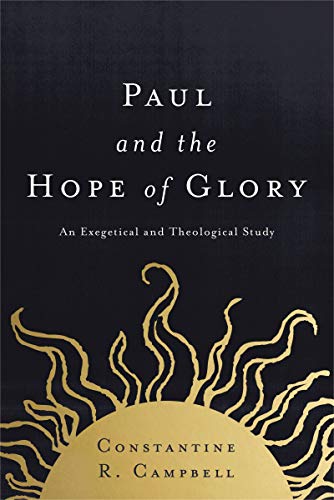A Brief Book Summary from Books At a Glance
by Mark Baker
About the Author
Constantine Campbell (PhD, Macquarie University) is senior vice president of global content and Bible teaching at Our Daily Bread Ministries in Grand Rapids, Michigan. He has authored many books including Paul and Union with Christ.
Overview
The present volume is the second installment of a series that covers exegetical and theological themes. Following the methodology set out in Paul and Union with Christ (the first book in the series), Paul and the Hope of Glory seeks to provide an exegetical and theological treatment of the main eschatological passages in Paul’s letters. Though this method is limited in that it cannot interact with the context of each passage, it seeks “to achieve something that commentaries and other monographs may not do as well, which is to relate thematic elements together across the Pauline corpus” (xxi–xxii). While this book cannot be reduced to a mere series of word studies, it does study the words Parousia, the last day, inheritance, and hope. These words can be summed up by the concept of realm, which is not represented by a certain lexical root, but rather refers to “concepts such as the kingdom, elemental forces, spiritual warfare, visible and invisible forces, and authorities, powers, and dominions” (7).
Table of Contents
Part 1: Introductory Matters
- Introduction and Methodology
- A Recent History of Pauline Eschatology
Part 2: Exegetical Study
- Two Ages and Two Realms
- The Parousia
- The Last Day
- Judgment
- Resurrection
- Eternal Life
- Inheritance
- New Creation
- Israel
- Glory
- Hope
Part 3: Theological Study
- Christocentric Eschatology
- Apocalyptic Eschatology
- The Age to Come
- This Present Age
- Conclusions
Summary
Part 1: Introductory Matters
We typically understand “eschatology” as “the study of the last things.” But Paul understands “eschatology” to include “the full sweep of the end, the present, and the past, with each informing and shaping the others” (4). For Paul, the coming of Jesus meant that the present age and the age to come have now overlapped. The “end” has come in the middle of redemptive history, so to speak. Paul’s eschatology, therefore, is shaped by the overlapping of these ages. The Spirit connects believers to this new realm and prepares them for their glorious future. The past events of the death, resurrection, and ascension of Christ are at the heart of Paul’s eschatology, and he expects the second coming of Christ “to usher in the resurrection of the righteous dead and judgment of all humanity” (8). . . .
[To continue reading this summary, please see below....]
The remainder of this article is premium content. Become a member to continue reading.
Already have an account? Sign In
